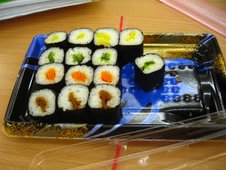Reading Labels in Kanji!
Japanese has three writing systems--Hiragana, Katakana, and Kanji (Chinese characters)Katakana is used primarily for writing foreign loan words. It can take a matter of a few days to learn to read and write both of these. The following is a good website for a basic introduction to Hiragana and Katakana: Yoshida Institute.
Kanji, on the other hand, takes years to learn well enough to read and write adequately. There are over 50,000 kanji, 2,000 of which are considered everyday kanji which are necessary to complete such basic tasks as reading the newspaper.
Here are the essential kanji to remember to facilitate vegetarian eating in Japan.
kanji pronounciation: meaning
原材料名 gensairyoumei: ingredients
On food products, this kanji will show you where you should be looking for the following kanji:
肉 niku: meat
牛 ushi: cow
牛肉 gyu-niku: beef
豚 buta: pig
豚肉 buta-niku: pork
鶏 tori: chicken
鶏肉 tori-niku: chicken
鳥 tori: bird or poultry
鴨 kamo: duck
加工油脂 kakouyushi: processed oil. The worry here is that there's no way to tell what kind of oil (animal or vegetable) has been processed.
魚 sakana: fish If this kanji appears as part of another kanji, it usually represents a particular kind of fish--carp (鯉), tuna (鮪), etc.
魚介 gyokai: seafood, fish and/or shellfish products
蟹 kani: crab
海老 ebi: shrimp
貝 kai: shell fish
烏賊 いか or イカ ika: squid
蛸 tako: octopus
鰹 かつお or カツオ katsuo: bonito flakes from dried fish—used in stock in all soups that otherwise appear vegetarian.
卵 tamago: egg
玉子 tamago: egg
牛乳 gyunyu: milk
乳製品 nyu-seihin: dairy products
Be wary of the 乳 kanji. It means the ingredient is milk or a milk derivative, except in these two combinations: 豆乳 (soy milk) and 乳化剤 (lecithin--usually, if not always, from soy).
(蜂)蜜 (hachi)mitsu: honey
毛 ke: wool
絹 kinu: silk
革 kawa: skin, pelt, leather
貝類エキス kairui ekisu: shellfish extract
肝エキス kimo ekisu: liver extract
牛肉エキス gyuniku ekisu: beef extract
魚のエキス sakana no ekisu: fish extract
食肉エキス shokuniku ekisu: meat extract
Here are some kanjì you might see on vegan foods (these are ok!):
野菜 yasai: vegetables
大豆 daizu: soy bean
豆乳 tonyu: soy milk
豆腐 tofu: tofu
If you are expecting to come to Japan and read labels, you must learn to read at least katakana. Even though there is a kanji for toriniku often it will be written as チキン (chikin) in katakana, similarly you may see タコ or たこ for tako.
Other katakana to look out for include:
Anything that could possibly be pronounced as gelatin (ゼラチン is most common, but I have seen others),
ショートニグ (shortening—often animal derived),
マーガリン (margarine-may contain animal ingredients),
バタ (butter),
ラード (lard)
If you don't recognize a word written in katakana, always make sure you read it in every possible pronunciation. Keep in mind that words are rendered in katakana according to pronunciation and not English spelling. Use your imagination!!



